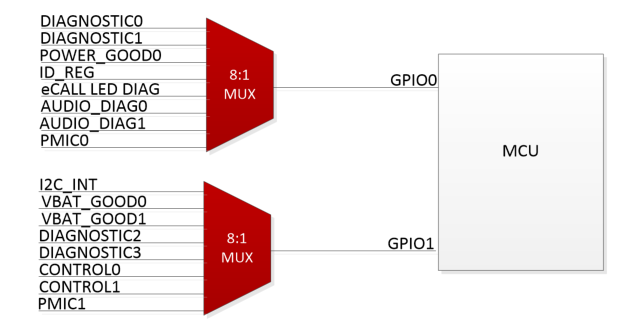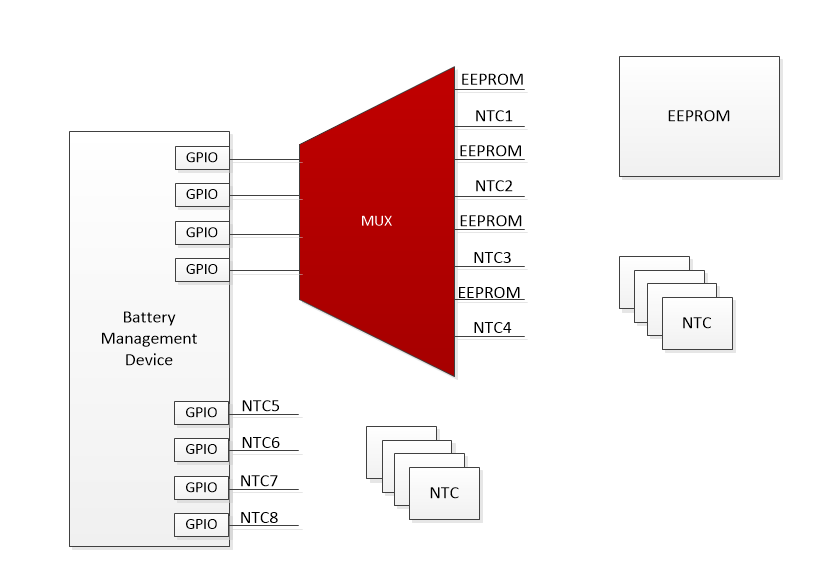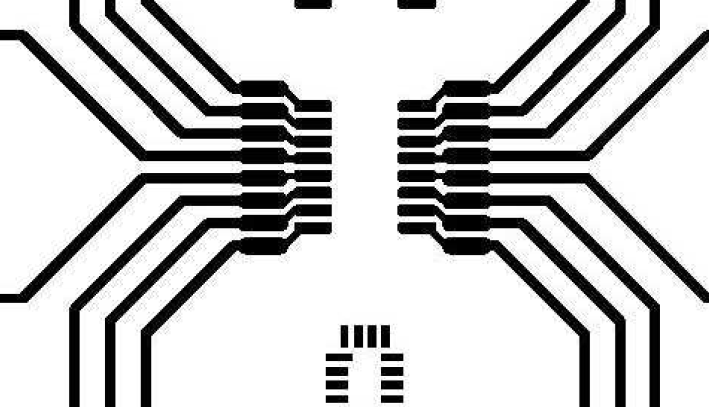SSZT252 september 2020 SN3257-Q1 , TMUX1308 , TMUX1574 , TMUX4051 , TMUX4051-Q1 , TMUX4052 , TMUX4053
We’ve all been there – a late requirement change has thrown your design in disarray, with little time to implement changes and few multiplexer options. There is a myriad of possible last-minute changes, but one that I often encounter when working with designers is how to monitor an increased number of nodes after the microcontroller has already been selected, as shown in Figure 1. One of the biggest challenges in this scenario, ironically enough, is the lack of available board space to fit an additional multiplexer. Fortunately, there’s a relatively easy solution involving small-size 8:1 multiplexers, such as the TMUX1308.
 Figure 1 General-purpose input/output
(GPIO) expansion with 8:1 multiplexers
Figure 1 General-purpose input/output
(GPIO) expansion with 8:1 multiplexersWhen you think small-size multiplexer, you may think your only option is to use a device in a quad flat no-lead (QFN) package. There is another option; however, multiplexers in small-outline transistor (SOT)-23 packaging. Figure 2 shows the size comparison of common 16-pin packages where you will notice the SOT-23 thin is a leaded package that is half the solution size of the thin-shrink small-outline package (TSSOP) used in most designs today.
 Figure 2 TI 16-pin package footprint
comparison
Figure 2 TI 16-pin package footprint
comparisonYou can easily replace a 16-pin TSSOP with two 16-pin SOT-23 thin devices and retain the ability to lay them out in a similar area. The SOT-23 thin package also uses a 0.5-mm pitch, which is a widely accepted manufacturing design rule and is easy to hand solder. It offers the size advantage of a QFN and includes leads which are helpful for debugging and prototyping, mechanical reliability, and optical inspection. SOT-23 packages are a good fit if you are trying to increase your board density but your requirements call for leaded packages.
| Optimize board space with compromising on performance or cost | |

|
Learn more about the benefits of small-size packaging in the technical white paper, “Simplifying Signal Chain Design for High Performance in Small Systems.” |
SOT-23 multiplexers can also help you handle last-minute requirement changes when you need to add a new system feature late in the design process. Figure 3 shows an example in which the choice of battery monitor circuit was locked, and all GPIOs were being used to measure multiple negative temperature coefficient thermistors (NTCs) around the system. Late in the design, the designer wanted to add a feature that would store battery-life information from the battery monitor in electrically erasable programmable read-only memory (EEPROM).
 Figure 3 Battery-management circuit
multiplexing between EEPROM and NTCs
Figure 3 Battery-management circuit
multiplexing between EEPROM and NTCsIn this example, the lead designer was interested in using the SOT-23 package but wasn’t sure if they could get the package qualified as an approved device for their company in time. I suggested that they use a multiplexer like the SN3257-Q1 or TMUX1574, which come in both TSSOP and SOT-23 thin package options. Since the SOT-23 thin footprint can fit inside the TSSOP footprint, as shown in Figure 4, they could place a dual footprint on their printed circuit board (PCB) and mitigate the risk of not having the SOT-23 package approved while continuing forward with the TSSOP package as a backup. Read the Analog Design Journal article, “Second-sourcing options for small-package amplifiers,” for more information on dual-sourcing PCB layouts.
 Figure 4 Dual-footprint layout; 16-pin
SOT-23 thin footprint inside 16-pin TSSOP footprint
Figure 4 Dual-footprint layout; 16-pin
SOT-23 thin footprint inside 16-pin TSSOP footprintIt is inevitable that last-minute challenges will come up when designing a system. Devices historically used to solve these issues now come in smaller package options, so don’t be caught without the tiny leaded SOT-23 thin package. The smaller package options have the size benefit of QFNs and the mechanical benefits of leaded packages. Qualifying the SOT-23 thin package on your approved device list in advance will give you another tool to accommodate last-minute changes on future designs.